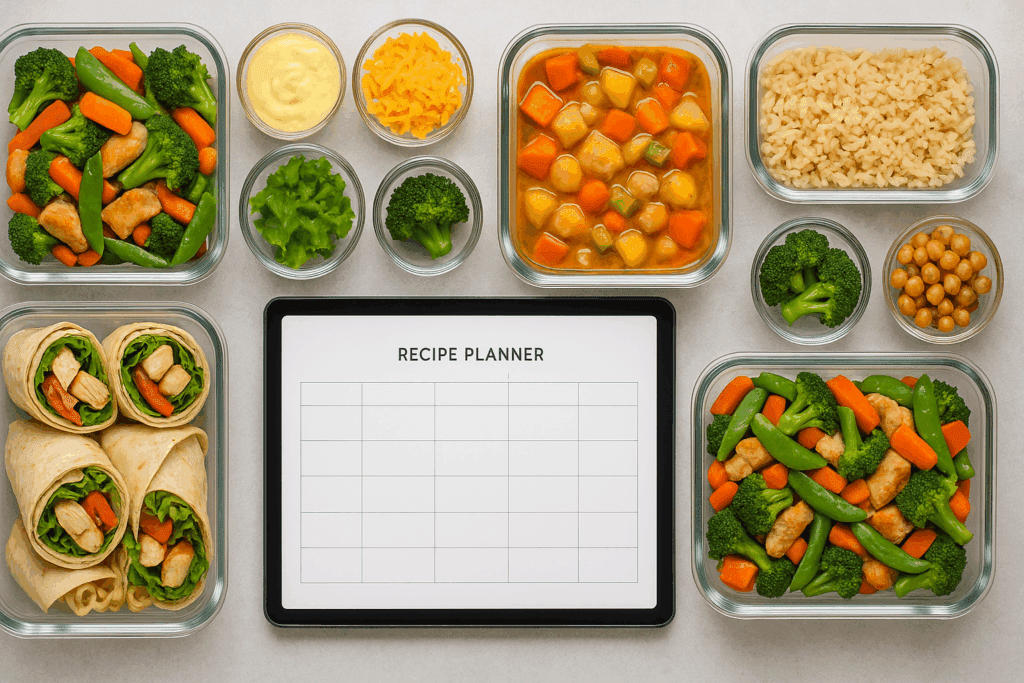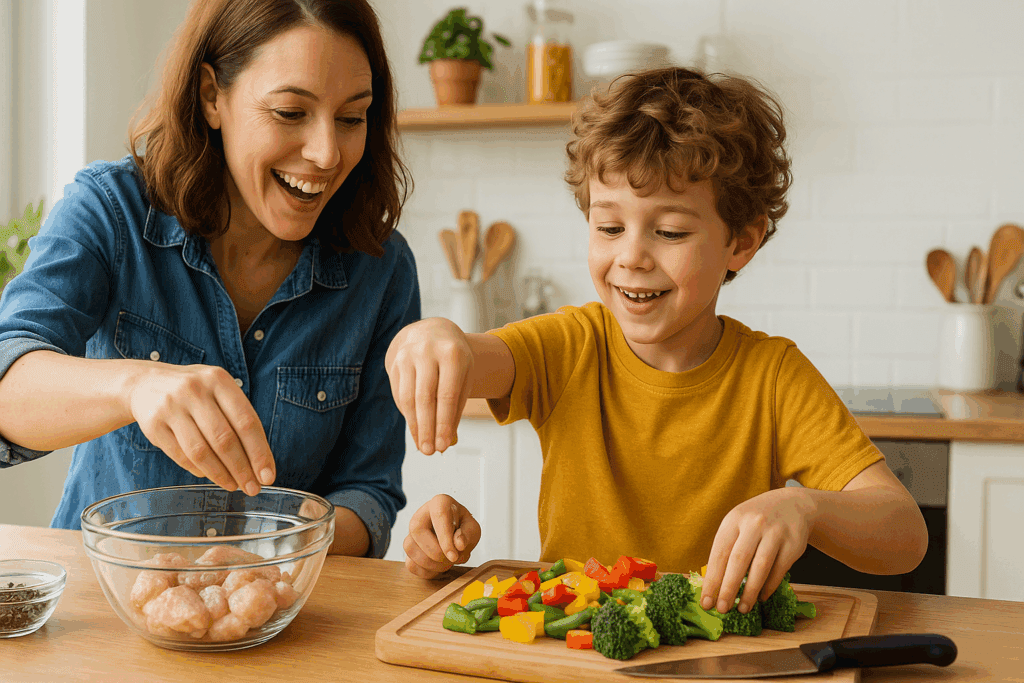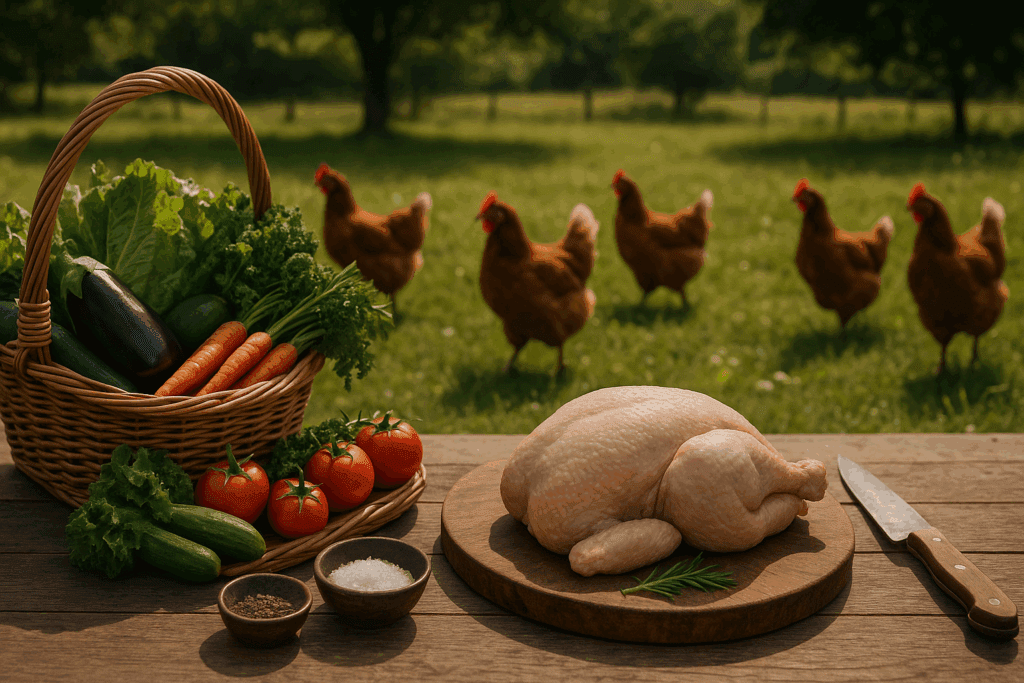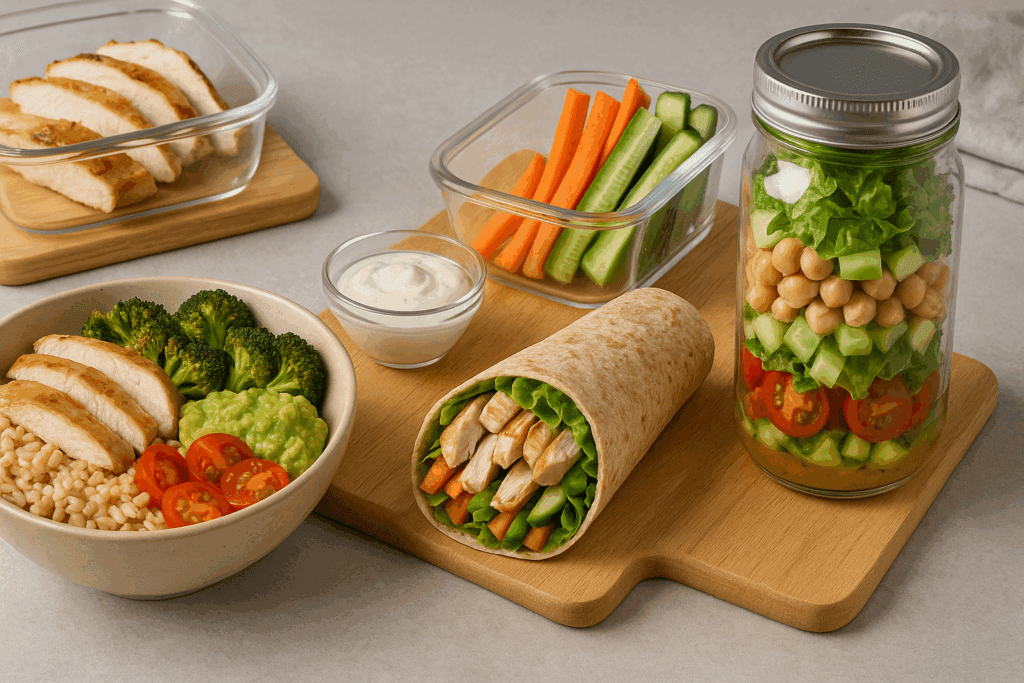Why Chicken Is the Foundation of Nutritious Family Meals
Chicken has long been a staple in kitchens across the world, and for good reason. It’s lean, protein-rich, and remarkably versatile, making it an ideal ingredient for creating meals that are both healthy and satisfying. For families seeking easy chicken dinner ideas for family wellness, chicken offers a reliable foundation that pairs beautifully with grains, vegetables, and herbs. When prepared thoughtfully, chicken supports heart health, muscle development, and immune function—making it a powerful ally in preventive nutrition.
You may also like: Delicious Meets Nutritious: How to Create Healthy Food with Flavor Using Expert-Backed Diet Recipes and Cooking Tips

The Nutritional Power of Chicken in Daily Family Diets
Incorporating chicken into regular meals can help families meet essential nutrient needs without adding excess calories or saturated fat. Skinless chicken breasts, for example, are low in cholesterol and high in niacin and vitamin B6, which are critical for energy metabolism. Easy chicken recipes for dinner for families can be customized to include vegetables, whole grains, and healthy fats, enhancing both flavor and nutritional value. These meals also provide satiety and stable blood sugar levels, which are essential for children’s concentration and adults’ energy throughout the day.
Transforming Suppers with Chicken into Wellness Opportunities
Creating suppers with chicken doesn’t mean settling for bland or repetitive meals. It’s an opportunity to get creative, exploring global cuisines and seasonal produce to keep the dinner table exciting. Meals like lemon-roasted drumsticks with garlic green beans or turmeric-spiced chicken with brown rice offer robust flavor while staying heart-healthy. Chicken also absorbs marinades well, allowing families to rotate sauces and spices without increasing sodium. In this way, a simple protein becomes the cornerstone of dynamic, balanced nutrition.

Meal Planning with Chicken for Busy Families
One of the most effective wellness strategies is establishing a rotating library of easy chicken recipes for dinner for families that require minimal prep but deliver maximum nutrition. Sheet-pan dinners, slow-cooked stews, and stir-fries can all be prepared in under an hour, making them ideal for weeknights. Planning ahead by cooking in batches or repurposing leftovers into the next day’s chicken lunch helps reduce food waste and saves time. For example, last night’s herb-roasted chicken can become a Mediterranean chicken wrap or a topping for a quinoa salad the following afternoon.
Chicken Lunch Ideas to Extend Healthy Eating into the Day
Lunch is just as important as dinner when it comes to family wellness. A balanced chicken lunch supports mental focus, sustained energy, and healthy metabolism throughout the work or school day. Grilled chicken wraps with vegetables and hummus, chicken and wild rice bowls, or mason jar salads layered with chicken, greens, and avocado are quick to assemble and easy to transport. These options offer a nutritious alternative to fast food and help families stay consistent in their commitment to better eating.
Avoiding Processed Foods by Cooking Food Chicken Meals at Home
By choosing to cook more food chicken meals at home, families gain greater control over ingredients and portion sizes. This reduces reliance on processed foods that are often high in sodium, sugar, and unhealthy fats. Home-cooked meals can focus on whole ingredients like fresh vegetables, legumes, olive oil, and herbs, aligning with preventive health goals. Parents can also reduce children’s exposure to additives by preparing kid-friendly meals like baked chicken nuggets with homemade dips or slow-cooked chicken tacos with fresh salsa.
Food Food Chicken: A Reflection of Culinary Tradition and Wellness
Though the phrase “food food chicken” may seem redundant, it underscores the comfort and familiarity that chicken brings to the table. From celebratory roasts to soothing chicken soups, chicken is a symbol of nourishment in many cultures. Modern families can honor these traditions while updating them for today’s nutritional needs. Classic recipes like fried chicken can be transformed into oven-baked alternatives using whole grain breadcrumbs and heart-healthy oils—retaining flavor while supporting cardiovascular health.

Encouraging Children’s Involvement in Healthy Cooking
One of the most effective ways to instill lifelong healthy habits is by involving children in the cooking process. Letting them help with simple steps like seasoning, stirring, or setting the table creates positive associations with food. Easy chicken dinner ideas for family kitchens are perfect for this, as the preparation is usually safe, straightforward, and visually rewarding. When kids help prepare meals, they are more likely to try new vegetables, understand where their food comes from, and feel empowered to make better dietary choices.

Supporting Special Diets with Chicken-Based Recipes
Chicken is one of the most adaptable proteins for special diets. For individuals managing high blood pressure, chicken prepared with garlic, lemon, and rosemary offers flavor without salt. For people with diabetes, pairing grilled chicken with high-fiber sides like lentils or roasted Brussels sprouts helps maintain blood sugar levels. Even for those recovering from illness or surgery, soft dishes like chicken soup or mashed sweet potatoes with shredded chicken provide nourishment without digestive strain. These meals highlight how food chicken dishes can be both therapeutic and delicious.
Mental Health Benefits of Cooking and Sharing Chicken Meals
Mealtimes offer more than just physical nourishment—they’re also important for mental and emotional wellness. Studies show that families who eat together have better communication, stronger relationships, and lower rates of depression and anxiety. Suppers with chicken can serve as a comforting daily ritual, grounding family members in a shared experience. Preparing meals from scratch encourages mindfulness, creativity, and collaboration, turning a routine dinner into a moment of meaningful connection.
Safe Handling and Storage for Healthy Chicken Meals
Food safety is a crucial aspect of family wellness, especially when handling poultry. Chicken should always be cooked to an internal temperature of 165°F and stored in the refrigerator within two hours of preparation. Properly cooling leftovers and storing them in airtight containers prevents bacterial growth and ensures meals stay fresh. These practices are especially important when preparing meals for children, elderly family members, or anyone with a weakened immune system. With careful handling, even large-batch cooking can be a safe and efficient way to enjoy chicken throughout the week.

Sustainability and Ethical Sourcing in Chicken-Based Meals
For families who prioritize sustainability and ethics in food choices, sourcing chicken from responsible farms makes a difference. Opting for organic, free-range, or pasture-raised chicken supports better animal welfare and reduces the environmental footprint of meat consumption. These options are often more nutrient-dense due to the chickens’ diets and lifestyles. In combination with local and seasonal vegetables, these meals can promote not only family health but also the health of the planet. Easy chicken recipes for dinner for families can be both eco-conscious and delicious, helping consumers align their values with their diets.
Integrating Chicken Meals into Long-Term Wellness Plans
Meal planning is a powerful preventive tool. When families build their weekly menus around lean proteins like chicken, they naturally create space for more vegetables, whole grains, and legumes. These choices are associated with reduced risk of heart disease, type 2 diabetes, and obesity. A chicken lunch or dinner, when prepared with intention, becomes more than just a meal—it becomes an investment in long-term wellness. Over time, the habits formed by consistently choosing nutritious meals will support better energy, healthier weights, and stronger immune systems.
Simple Doesn’t Mean Boring: Creative Ways to Cook Chicken
It’s a myth that simple meals are bland or repetitive. With a few core ingredients and some imagination, families can prepare dozens of flavorful variations on classic chicken dishes. Think harissa-spiced grilled chicken with couscous, coconut curry chicken with chickpeas, or balsamic-glazed chicken with roasted root vegetables. The beauty of easy chicken dinner ideas for family eating is their adaptability. With smart seasoning and thoughtful sides, the same base protein can become a global culinary tour without leaving your kitchen.

Repurposing Leftovers for Maximum Efficiency and Nutrition
One of the most sustainable and budget-friendly habits is learning to repurpose leftovers creatively. Leftover chicken from dinner can become a hearty chicken lunch the next day, minimizing waste and saving time. Adding it to a vegetable stir-fry, stuffing it into whole grain pita with tzatziki, or blending it into a chicken salad with Greek yogurt and herbs are just a few ideas. These food chicken options reduce the temptation to grab convenience foods while maintaining a consistent intake of healthy nutrients throughout the week.
Cultural Traditions Reinvented for Today’s Health Goals
Chicken has played a role in cultural food traditions for centuries, from Moroccan tagines to Southern-style Sunday roasts. Families today can preserve these traditions while updating them for modern health concerns. This might mean using less oil, replacing white rice with farro or quinoa, or baking instead of frying. These small shifts maintain the flavor and joy of tradition while aligning with evidence-based nutritional guidance. Suppers with chicken can thus honor heritage while promoting a healthier future.
Frequently Asked Questions: Easy Chicken Recipes and Family Nutrition
1. How can I elevate easy chicken dinner ideas for family nutrition without making meals overly complex?
To elevate easy chicken dinner ideas for family nutrition, think beyond just switching up spices. Incorporate nutrient-dense add-ons like fermented foods, high-fiber grains, or calcium-rich leafy greens. Try serving grilled chicken over farro and spinach tossed in lemon-tahini dressing, or bake chicken with a probiotic-rich yogurt marinade. Another great tip is using bone-in chicken, which adds collagen and depth of flavor. By layering nutritional diversity, these easy chicken recipes for dinner for families can become wellness-packed meals without extending prep time.
2. What are some underutilized cuts for healthier suppers with chicken that don’t compromise flavor?
While chicken breasts are often praised for being lean, other cuts like thighs or drumsticks (skin removed) provide richer flavor with minimal additional fat. Bone-in thighs, in particular, are ideal for slow roasting or braising, allowing for maximum juiciness in suppers with chicken. For calorie-conscious meals, try poaching drumsticks or using thigh meat in vegetable-forward curries. These options bring depth and texture to any food chicken dish while still supporting a heart-healthy diet. They also tend to be more budget-friendly and sustainable than white meat.
3. How can food chicken meals support mood and mental clarity throughout the day?
Chicken is rich in tryptophan and B vitamins, both of which play a role in serotonin production and brain function. Including chicken in meals alongside complex carbohydrates like brown rice or quinoa can enhance its mood-boosting effects. A warm food chicken dish like chicken soup with sweet potatoes and kale isn’t just comforting—it also provides slow-digesting carbs that stabilize energy and support cognition. Chicken lunch options like stir-fry bowls with edamame and soba noodles can help reduce midday slumps. Consistently integrating these meals supports emotional wellness in both adults and children.
4. What are innovative ways to make chicken lunch more exciting and functional for school or work?
To elevate chicken lunch routines, consider using global flavor profiles and layered textures. Bento boxes with grilled chicken, seaweed salad, roasted chickpeas, and soba noodles offer visual appeal and diverse nutrients. Another creative approach is mason jar salads layered with lemon herb chicken, roasted vegetables, and whole grain couscous. These portable meals keep well, and when assembled mindfully, transform leftovers from suppers with chicken into crave-worthy midday fuel. Adding small dressings or spice blends in separate containers also keeps things fresh and interesting.
5. Can food food chicken meals help manage inflammation or chronic health issues?
Absolutely. Though the term “food food chicken” may seem redundant, it reflects the centrality of chicken in daily anti-inflammatory meal plans. Chicken prepared without processed additives or deep frying is rich in protein and low in saturated fat—ideal for reducing systemic inflammation. Meals like turmeric-roasted chicken with cauliflower or Mediterranean chicken stews with olive oil and garlic offer powerful anti-inflammatory effects. Incorporating omega-3-rich ingredients like walnuts or flax in side dishes can further enhance these benefits. Such thoughtful combinations turn food food chicken dinners into integrative tools for managing chronic conditions like arthritis or metabolic syndrome.
6. How do I ensure easy chicken recipes for dinner for families remain allergy-friendly without compromising taste?
The key is to use simple, whole ingredients while steering clear of common allergens like dairy, soy, and gluten. For instance, use coconut yogurt instead of dairy-based sauces or arrowroot flour as a thickener in gravies. A popular allergy-conscious recipe includes roasted chicken thighs with rosemary, served alongside roasted root vegetables and a lemon vinaigrette. These easy chicken recipes for dinner for families are naturally gluten- and dairy-free, yet full of comforting, savory flavor. Batch-cooking these meals also ensures allergy-safe leftovers for lunch the next day.
7. What psychological benefits can families gain from consistent suppers with chicken at home?
Sharing regular suppers with chicken has a deeper psychological impact than often acknowledged. When families sit down together, it fosters communication, trust, and emotional regulation in children. Preparing these meals collaboratively reinforces teamwork and nurtures autonomy in young eaters. Over time, familiar routines built around food chicken can reduce stress by providing structure and predictability in the household. Such mealtime rituals contribute to long-term resilience, stronger relationships, and even improved academic outcomes in children.
8. What are sustainable ways to use leftovers from food chicken dinners?
Repurposing leftovers efficiently reduces waste and adds variety to the weekly menu. Shred leftover roast chicken for tacos, use diced pieces in a vegetable frittata, or fold them into a homemade chicken noodle soup. A less conventional option is using food chicken bits to make savory breakfast grain bowls with eggs, greens, and avocado. These smart, sustainable ideas not only lower grocery bills but also maximize nutritional output from a single meal. A well-designed chicken lunch from leftovers can be just as satisfying as the original dinner.
9. How can food food chicken dishes support athletes or active individuals?
Food food chicken meals are ideal for fueling performance and supporting muscle recovery, especially when timed post-workout. Pairing grilled chicken with a magnesium-rich side like sweet potatoes or spinach can enhance recovery by reducing cramping and fatigue. Chicken stir-fries with bell peppers and jasmine rice provide glycogen replenishment and muscle-building amino acids. For sustained energy, combine chicken with complex carbs and healthy fats, such as a quinoa salad with chicken, avocado, and olive oil. Athletes can benefit from these balanced, protein-forward meals at both dinner and chicken lunch times.
10. How might easy chicken dinner ideas for family routines evolve in the future?
As food trends evolve, easy chicken dinner ideas for family use will likely become more tech-assisted and sustainability-focused. Smart kitchen tools, like air fryers or programmable pressure cookers, are already simplifying prep and improving nutrition retention. There’s growing interest in regenerative farming and responsibly sourced poultry, making eco-conscious choices more accessible. Additionally, AI-generated meal planning apps now suggest easy chicken recipes for dinner for families based on pantry inventory and dietary preferences. These tools help families streamline decision-making, reduce food waste, and discover new food chicken combinations tailored to their wellness goals.
Conclusion: Embracing Everyday Wellness Through Easy Chicken Recipes for Families
Easy chicken dinner ideas for family life are more than just a culinary convenience—they’re a bridge between nourishment and connection, between tradition and modern wellness. By incorporating whole ingredients, reducing reliance on processed food, and involving all members of the family in the cooking process, chicken meals become powerful vehicles for health and happiness. Whether it’s a simple chicken lunch packed with fiber-rich vegetables or a flavorful supper made from scratch, food food chicken remains at the heart of balanced, sustainable eating.
As families strive to make healthier choices, integrating easy chicken recipes for dinner for families into the weekly routine offers a practical and proven path forward. These meals support cardiovascular health, energy metabolism, immune resilience, and emotional well-being. They can be budget-friendly, culturally rich, and adaptable to nearly any dietary need. Most importantly, they bring families together—around the table, in the kitchen, and in shared moments that nourish body and soul alike.
Further Reading:
15-Minute Honey Garlic Chicken
The Chicken Recipe That Changed My Life
70 Easy Chicken Dinners You’ll Make on Repeat


